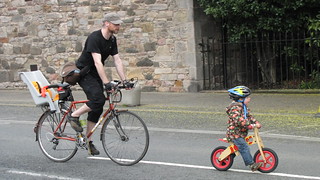I think that putting trams down the NEPN between Roseburn and Crewe Toll is a stupid idea for the most part, for reasons I've written about before, but essentially, trams, like buses and trains, have to do two things:
- Pick up and drop off people at popular, useful locations
- Get between those locations as fast as possible
Unlike trains, trams are designed to snake their way left and right and up and down through tight places, so you can serve on-road locations as required, dive underground as required, and it's stupid not to take advantage of that.
Trying to serve both Craigleith retail park and the WGH using the railway alignment alone does neither well. Trying to put trams over the Dean Bridge is engineeringly hard.
My solution would be:
1) Sacrifice some of the NEPN, from Roseburn to South Groathill Avenue.
2) Build a stop right at the pedestrian entrance to the retail park.
3) On-road running onto Telford Road.
4) Build a stop next to the WGH western entrance.
5) On-road running on Telford Road and Ferry Road.
6) On-road running as far as Granton Road, then a descent off Granton Road to the NEPN eastbound.
7) Sacrifice some of the NEPN, from Granton Road to Craighall Road.
8) Sacrifice the Victoria Path access to Victoria Park, running a loop up to join Craighall Road northbound.
9) On-road running on Craighall Road to Pier Place and Lindsay Road to join the existing route.
If they can build that, there will I'm sure be money to later build a loop line that connects Crewe Toll, Granton and Newhaven, and a spur from Princes St to the RIE and beyhond. I reckon running the trams up the Mound, along Forest Road, MMW, Melville Drive, Minto St, Lady Road and the RIE is probably quite sensible, as it would bring footfall for the university, and it would be easy to realign MMW paths.
It's all so much armchair thinking though. Much as I really like the trams, I think we are unlikely to see any of it built unless Council Tax goes up a lot and we get some kind of congestion charge (heh, maybe on-road trams would be a cost neutral approach...).
It does beg the question how Edinburgh Corporation managed to afford cable trams across much of the (much smaller) city, and then afford to convert them all to electricity and expand the network, when we didn't even have computers.

 posts
posts
